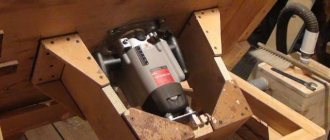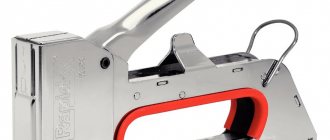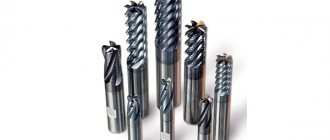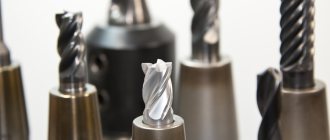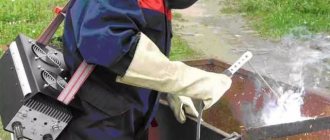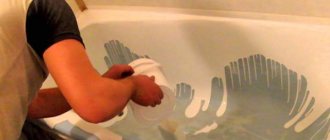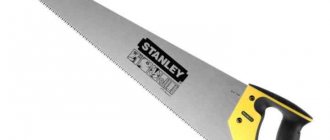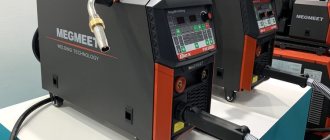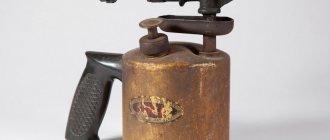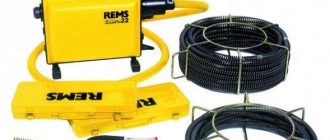The principle of the structure of cutters
Despite the variety of types that can be found in stores, they all have a common type of design.
There are two main parts of the design:
- shank;
- Workspace;
The first is installed in the router chuck and is designed to transmit torque.
The work area is where the blades are. This part can be straight or with an original shape. This determines what kind of work a particular tool is suitable for.
The cutter may include additional elements, such as bearings, screws, washers, calibration bushings, locking couplings. They are needed to make work easier or to expand functionality.
Main characteristics
Milling cutters have their own characteristics that you should pay attention to.
Shank diameter
Depending on the size of the cutter, various clamping elements for the shank are manufactured. First of all, you should check in what units of measurement the size of the latter is indicated - in inches or millimeters. If the units of measurement between the shank and the clamping element do not match, problems will arise that will reduce the life of the router and reduce the quality of work.
Length of cutter and cutting base
The normal length of the cutter is considered to be 60-210 mm, the cutting base is 15-125 mm. Long tools have increased parameters: 105-250 mm and 55-140 mm, respectively. They are mainly used for roughing. Short cutters are used for working with various materials and roughing. Their sizes: 60-205 mm for the cutter, 15-120 mm for the cutting part.
Alloy
Type of alloy used to make tools:
- solid carbide;
- carbide-tipped alloy.
The main characteristic of solid carbide is maximum precision when working with wood.
Carbide-tipped alloy parts are equipped with cutting parts of various shapes, thereby increasing the range of tasks performed. They need to be sharpened less often than representatives of the first option, but the sharpening process itself is more complicated.
Chip removal
There are different types of waste disposal:
- Single-pass with chip removal upwards.
- Double-thread with chip removal upwards.
- Three-start and four-start with chip removal upwards.
- With chip removal downwards.
- With straight knives.
The first type features one edge and a groove. The chips do not melt or stick to the tool.
The latter are designed for high-precision processing due to their rigid structure. The cut is smooth and clear.
Still others are characterized by a large number of working edges, which increases the speed of work to the maximum.
The fourth ones are suitable for working with single-layer material. Due to the special impact on the material from above, these cutters eliminate the need for locking elements so that the product remains in place during the process.
Fifth ones are used when working with multilayer materials. Well suited for punching grooves.
To prevent rapid wear, cutters should be used in the types of work for which they are intended.
Types of cutter designs
The following types are distinguished:
- prefabricated ones are easy to manufacture and the most popular. They are elements of the cutting part welded to a steel base;
- with replaceable edges - this type can be used longer due to the ability to turn the double-sided blade over when it becomes dull;
- monolithic - they are a single piece of metal in which the cutting part is cut out. The inability to break a knife in such a cutter is compensated by the need to replace the entire part after several sharpenings.
Types of cutter blades
When examining cutter blades for a manual wood router, the following types and types are found:
- knives made of high-speed steel. Marked with the letters HSS. It is necessary to choose when working with soft wood;
- knives made of carbide metals. Marking – HM. Mainly used for working with hard materials. Durable and resistant to elevated temperatures.
In addition, there are a number of varieties of blade shapes:
- vertical;
- inclined;
- spiral.
Inclined ones provide a better quality end result by cutting pieces of wood rather than chopping down, as vertical knives do.
Designs of cutters and their influence on the technology of milling operations
The instruments under consideration are divided into several main categories, classified by type and purpose. They perform their functions not only under axial load, but have the ability to move during operation due to the presence of side edges. Cutting edges, or rather their number, directly depends on the quality of the actions performed by a manual router.
The tool used for processing is considered to be a manual milling cutter. There are crown-type tools; they allow you to perform work with an ordinary drill. In this case, the milling head used for wood performs the role of processing edges and making simple holes.
Wood cutter knife
Milling head
The design and production of products with grooves of the required depth and size is carried out using end mills. Knives used for wood milling are subject to considerable loads. Preventing unnecessary machining is achieved through the use of bearings. Hand router end mills allow you to create joints in wooden structures using a tongue/groove system.
To make the necessary hole in the tree, you will need a burr. In most cases, such a tool is used for intermediate processing. The cutters allow you to “open” the hole to the required depth, after which further actions are performed.
Grooving cutters
Designed for creating grooves, grooves and forming decorative surfaces in workpieces. There are several types of goods on the market.
Direct
A simple piece in the shape of a cylinder. Can be used:
- like a drill bit;
- to create grooves;
- for splicing workpieces;
Fillet
Designed to create fillets - semicircular recesses that can be located in the edges, main planes and ribs. They have a shape similar to the "U" symbol. They can create recesses of increased complexity to decorate the workpiece. They are distinguished by high quality and reliable results.
V-shaped fillets
They differ from the previous type in the shape of the tip, which is made in the shape of the letter “V”. They come in handy when you need to create grooves at different angles.
Structural (T-shape and dovetail)
Used to create T-slots. “Dovetail” is another subspecies of this type, which is used for the same purposes, but is slightly different in shape. A lot of experience is required to operate these tools. Grooves made using such a tool are considered one of the best ways to connect wooden parts to each other.
Shaped
Suitable for creating the most complex planes and grooves. The grooves are shaped like braces. Created according to the requirements of a specific customer. They are used to solve various specific problems. They have a large working resource. Allows you to reduce the amount of time required to work with the workpiece.
When creating a complex pattern, you can first go along the contour with a straight phase cutter to simplify the process.
Areas of application
To equip a manual wood router today, various tools are offered, each of which is designed to perform specific technological tasks.
End mills
End mills in their design are very similar to conventional drills, the working end of which does not have a conical part. The design feature of wood end mills is that their end part, located at an angle of 90° to the sides, also has cutting teeth. This design feature allows the use of cutters of this type to perform various technological operations, which, in particular, include:
- drilling;
- creating grooves on the surface of the workpiece, including through-type ones;
- quarter sample;
- cutting blanks;
- edge processing.
Spiral end mills cut grooves, make holes and process contours
In addition, with the help of such a universal tool, you can process stepped surfaces, cut grooves for door locks and hinges, and also solve many other technological problems.
Slot cutters
- straight cutters for cutting grooves of a rectangular profile (this also includes a finger cutter for wood for a manual router);
- shaped cutters for woodworking, with the help of which grooves of a shaped configuration are made on the surface of the workpiece (a shaped cutter, in particular, allows you to imitate a panel pattern on the surface of the workpiece);
- cutters for creating grooves with a dovetail configuration (such a technological operation requires the use of a special template);
- structural cutters, which are used to select grooves in a T-shaped configuration (in this case, it is necessary to ensure effective removal of chips from the groove being formed);
- cutters with a cone-shaped working part (with their help, engraving work is performed with a manual milling cutter, and grooves of a V-shaped configuration are created);
- fillet tools used to select grooves of a semicircular configuration on the surface of the workpiece (a fillet cutter is often used to perform decorative processing of wood products).
Examples of slot cutters
Edge milling tool
Edge cutters, which are among the most common tools used for hand router work, are also divided into several categories:
- straight cutters, also known as copy cutters and often equipped with a guide bearing (they allow you to create perfectly straight edges on the workpiece);
- shaped edge cutter, or profile cutter, with the help of which the edge of the workpiece can be given any configuration;
- figurine cutters used for making door panels and baseboards;
- a cone-type tool for hand-held milling cutters, with the help of which the edge of the workpiece is cut at the required angle (the design feature of cutters of this type is that they are almost always equipped with guide bearings);
- edge molding cutter, used to give the edge of the workpiece a rounded shape (edge molding cutter, as a rule, is also equipped with a guide bearing);
- a fillet tool, like an edge moulder cutter, allows you to process the edges of a product in an arc, but give them a concave rather than a convex shape (by design, such a tool and an edge moulder cutter are a mirror image of each other; like an edge moulder cutter, a fillet tool most often equipped with a guide bearing);
- microtenon cutter, which allows the formation of thin triangular tenons on the surface of the workpiece, used to create a connection between two joined wooden parts.
Some types of edge cutters
Edge cutters
They are a cutting tool for working with edges and creating the desired shape. The following types of such parts can be distinguished.
Direct
Simple and common, these cutters produce flat, straight, perpendicular type edges. The version with a bearing makes it possible to work with round shapes.
Mouldings
The goal of this type is complex patterns. Consist of two cutting parts. Suitable for straight machining, smooth bends and rounding.
When choosing this type of cutter, it is recommended to take those that are equipped with the ability to adjust the distance between the cutting elements.
Folded
Suitable when you need to make rectangular grooves on curved or straight parts. They make it possible to obtain the result of the desired shape through a double pass.
Conical
A special type used by furniture manufacturers. Used for processing parts before joining. By changing the angle of inclination of the cutting part, decorative chamfers are achieved for connecting products of polygonal and round shapes.
Fillet
Used when you need to make a rounded groove. Equipped with two bearings that protect the tool from distortion. The result is similar to that obtained with groove fillet cutters, but edge cutters are sometimes more convenient.
Curly
Characterized by heavy weight. Used on large professional machines. They speed up the process by working over the entire area of the product. You can combine different elements.
Half-rod
Used to create semicircular protrusions on edges. Transform rectangular blanks into rods. You can make chamfers and edges of complex shapes and hinged joints. To do this, you will have to, along with a half-rod cutter, process the part with a fillet or molding tool.
Functional cutter sets
You can often find functional sets on sale that consist of two or more elements. This set includes accessories and attachments for a wood router. The main purpose of such kits is to process two or more parts to obtain similar connections. For example, there is a set of 2 cutters, one of which forms an edge inside the product, and the second allows you to make a groove part.
There are universal options that, thanks to their design, can be used for various purposes. The collapsible part involves replacing the cutter blades, after which work with wood is carried out.
It is worth noting that the presence of a table for storing all types of equipment accessories will reduce the time for the actions performed, and it is also possible to build something like a milling machine. By installing movable stops on the table, the master expands the range of possibilities of the tool for woodworking.
Combined cutters
Used to combine parts along the end or edge. In addition to the main purpose, they also grind and expand the surface. To choose the right type of cutter, you should familiarize yourself with the subtypes.
Combined universal
They create a junction of two parts with a groove and a tenon. They save time due to the ability to process both workpieces being combined without changing the attachment.
Tongue-and-mortise
They differ from the previous version in that the groove is on one of the workpieces being connected, and the tenon is on the other.
For the manufacture of lining
The purpose is the same as in the tongue-and-groove version, with the difference that shaped recesses are created for a more reliable connection.
Combined frame
Bearings, knives, retainer and washer are located on the same base. Used in multi-complex works. When working with this type, a specialist can arrange the cutting blades in an order convenient for him.
Copy cutters
The least common type of attachment when performing woodworking tasks with hand tools is copy cutters. Distinctive features are the numerous types of cutting elements, different locations of thrust bearings and small sizes. The milling head for wood crafts is arranged in the shape of an arc. The depth into the part depends on the processing angle.
Using a tool according to a template allows you to achieve the desired result when working with wooden workpieces. It is necessary to use a hand router with precision and caution; failure to comply with the requirements may lead to damage to the part or electrical equipment.
Figurine cutters
Used when necessary to make shaped chamfers and decorative edges. The bearing makes it possible to use shaped and rectangular workpieces. There are three subtypes of cutters.
Horizontal
Used for processing panels. Including decorative ones. Thanks to the bearing, you can work with straight and curved edges.
Horizontal double-sided
They reduce processing time due to the ability to perform in one pass, immediately creating a shaped part and a tenon for the groove.
Vertical
The most common application is the creation of skirting boards. Although the capabilities of these cutters are not limited to this. The result of the tool is a decorative part and a tenon joint.
Having studied the types of wood cutters for a manual router, you can go to the store to choose the appropriate option and get to work. And all the variety of options will allow you to do any job that you can think of.
Equipment for working with wood cutters
The cutter is the main part of almost any woodworking tool. It can be installed:
- into a regular drill;
- milling machine (milling machine);
- industrial equipment.
Power tools can be used to carry out rough and fine processing of wood at high speed.
Drill
The use of cutters allows home craftsmen to significantly expand the functionality of a conventional drill intended only for drilling. At the same time, the drill turns into a universal tool with which you can process parts made from various types of wood.
Using wood cutters designed to work with a drill, you can produce large-diameter holes without the use of special drill attachments such as ballerina or crown (crown attachment).
To work with a drill, only finger cutters are used, the cutting edges of which have a wide variety of shapes. In addition, fillet, edge (quarter) and cone cutters are often equipped with a support bearing, which limits the depth of cut of the blades into the wood.
Cutting blades can be pointed or backed. Pointed teeth have flat front and back surfaces, and they are sharpened along the back surface.
Moreover, during re-sharpening, the cutting part may change its geometric dimensions. This can be avoided by using a tool with sharpened blades. They only have a flat front surface, along which sharpening is carried out. You can resharpen such cutters many times without fear that the geometry of the cutting edges will change.
Fraser
A hand router is a tool that is designed for processing various lumber and products made from it. It differs from a drill in the presence of an adjustable support platform and the ability to operate at high speeds (up to 30 thousand rpm). Using a router you can with high quality:
- splice different workpieces, connecting them using the “tenon/groove” method (edge work), chamfer the timber;
- embed fittings, locks, hinges;
- form three-dimensional shapes on flat surfaces (decoration);
- cut wooden blanks with complex configurations.
To perform these works, edge, groove, copy and end mills for wood are used.
Groove cutters are used when you need to make recesses of a certain shape, for example, in the shape of the letter T (T-shaped), semicircular or dovetail.
Edge cutters are used to make edges on wood parts. As a rule, they are equipped with a thrust bearing, which prevents excessive immersion of the tool into the body of the part. In addition, it allows you to adjust the depth of departure. If a bearing is not provided, then a parallel stop or template must be used.
For decorative processing of panel parts, horizontal type figurine cutters are used. They are quite heavy and have a large diameter. Considering the great effort required when working with such cutters, they are equipped with a shank with a diameter of 12 mm. They are used on stationary equipment.
Wood end mills for a hand router have cutting edges located at the end of the working surface. In addition, the side edge also takes part in the work, which allows you to move the rotating cutter in the plane of the support platform. The quality of surface treatment is determined by the number of cutting blades. As a rule, end mills have a monolithic design, but there are also composite ones.
A separate group of end products consists of Shaper cutters - cutters (burrs).
They are used at intermediate stages of processing, as well as in cases where it is necessary to finalize the configuration of the part. Their cutting edge consists of large notches (teeth). When working with a cutter, it is important to choose the right mode. This will avoid burning the wood, which is possible at higher speeds. And the original “corn” burr (a cutter with a screw arrangement of teeth) will reduce the load on the shaft of the electric motor of the router.
Copy cutters are a rare type of tool for a hand router. They differ not only in the number of cutting edges, but also in the placement of support bearings, which can be located on either side. Some models have two bearings (top and bottom). During operation, the bearing moves along a template, due to which the workpiece being processed takes on the desired shape.
